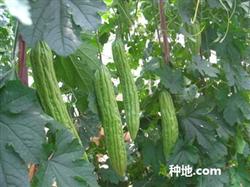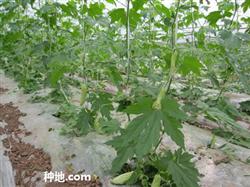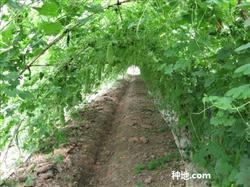How to plant balsam pear efficiently?

How to plant balsam pear efficiently? Please guide balsam pear, also known as cold gourd, is a cucurbitaceae vegetable plant, like high temperature, more heat-resistant, not cold-resistant, can be planted in our county all the year round. In recent years, with the continuous adjustment and optimization of crop structure and the continuous development and demand of melon and vegetable consumption market, balsam pear has become one of the specialty vegetables for northward transportation and export in our county. First, select improved varieties. In recent years, the improved varieties selected in our county are Penang balsam pear in Thailand, precocious Thai balsam pear and Australian balsam pear. Especially Australian balsam pear is more popular. The variety is medium-late ripening, fruit length 25-30 cm, transverse diameter 5-8 cm, skin color light green, meat thickness 1.2-1.5 cm, meat tender and smooth, slightly bitter, good quality, single fruit weight 250-500 grams, high yield. Second, land selection and land preparation. It is better to choose land close to water source, deep soil layer, loose and good drainage. Third, sow seeds at the right time. The best sowing time is from July to August for planting balsam pear in autumn and November to December for winter planting. Especially the autumn planting climate is suitable, the harvest time is long, and the yield is high. Its products can not only be transported northward, but also be exported to earn foreign exchange, with better economic benefits. Fourth, reasonable close planting. Balsam pear grows vigorously, and the lateral root has a long growth period. The suitable density (specification) should be reasonable, and the general row-plant spacing should be (120-140) / 2 × 120 cm for "human" and (130-170) / 2 × 110 cm for "π", with 400-450 plants per mu. Fifth, apply enough basic fertilizer and sow seeds carefully. When planting, plough (open) the ditch according to the planting specifications, dig holes in the ditch, turn the retted calcium superphosphate (100kg) with high-quality soil fertilizer or cow pen manure (1000-1500 kg) and imported Finnish N15P15K15 compound fertilizer (7-8 kg) in the hole, and then sow the seeds in the hole, 1-2 seeds in each hole (seeds sowed with dried kernels or soaked in water for 3-5 hours), then drench enough water. You can also first mix the imported Finnish compound fertilizer with the soil, pour enough water, and then sow the seeds, and then cover the seeds with high-quality soil manure or cow manure. Sixth, building a shed and pruning. When the seedlings have 5-6 true leaves, the bamboo should be planted in time to build a shed. There are two kinds of scaffolding: "human" shed and "π" shed, which vary with different materials. When the melon seedlings grow to 50-60 cm, they can draw the vines on the shed and release them evenly on the scaffolding. After introducing the vine to the shed, remove the short, weak and residual side vine (branch) within 40 cm of the base of the main vine and the upper part of the vine that does not bear female flowers. 7. Scientific fertilization and use of water. The principle of "light application at seedling stage and repeated application at flower and fruit stage" should be grasped in fertilization of balsam pear. When the seedling height is 70-80 cm, 40-50 kg of phosphate fertilizer, 15 kg of nitrogen fertilizer and 10 kg of potassium fertilizer are applied per mu in the hole, and 30-35 kg per mu of compound fertilizer is applied between rows at full flowering stage. The variety, time and quantity of fertilization in the future, according to the situation of seedlings, depends on the weather. Balsam pear likes to be moist and avoid stagnant water. The use of water can be reasonably adjusted according to the dry and wet condition of the soil. Prevention and control of diseases and insect pests. Powdery mildew and leaf spot: spray with 1500-2000 times of 25% biprolol or 25% chlorothalonil. Epidemic disease: sprayed with 80-1000 times liquid of 60% Tianyuke or 64% antidote alum 150g and 50kg water. Spodoptera litura: sprayed with 45% Amoma 1000-1500 times. Aphids: 10% Shikejing 10-20 grams per mu with 50 kg water or 3000 times the solution of 10% aphid lice. Melon fruit fly: use 10% to die quickly or 25% to spray 1000 times the liquid. Click to get more balsam pear planting techniques click to get more vegetable planting techniques
- Prev

How to cultivate balsam pear in open field?
How to cultivate balsam pear in open field? Please guide Momordica charantia scientific name for Momordica L. alias has cold melon, golden litchi, said the grape, is a gourd family Momordica cultivated species, an annual climbing herb. It originated in subtropical regions; in South China, North China, Central China, Southwest China are planted...
- Next

How to cultivate out-of-season balsam pear?
How to fertilize and irrigate balsam pear scientifically? Please guide balsam pear to bear melon for many times, harvest time is long, and consume a large amount of water and fertilizer in life. Therefore, fertilizer and water management is an important guarantee for high yield. In addition to the application of sufficient base fertilizer, topdressing is generally applied again in vines, flowering and fruiting, and topdressing at seedling stage can be less. The first time I topdressing was in.
Related
- Where is it suitable to grow horseradish in China? it is expected to see the middle altitude horseradish in Alishan.
- How to prevent tomato virus disease reasonably? (Control methods included)
- Many people like to plant towel gourd on the balcony. What are the main points of this method and management?
- What crops can chili peppers be mixed with?
- Fertilization techniques and matters needing attention in Tomato
- What are the grafting techniques for peach seedlings in spring?
- Harm and control methods of root swelling disease of Chinese cabbage
- What are the pests of sweet potatoes? How to prevent and cure it?
- Symptoms, causes and Control methods of navel Rot in Tomato
- The cause of "Cucumber rotten bibcock" in Farmers' planting Cucumber and its Control Plan

